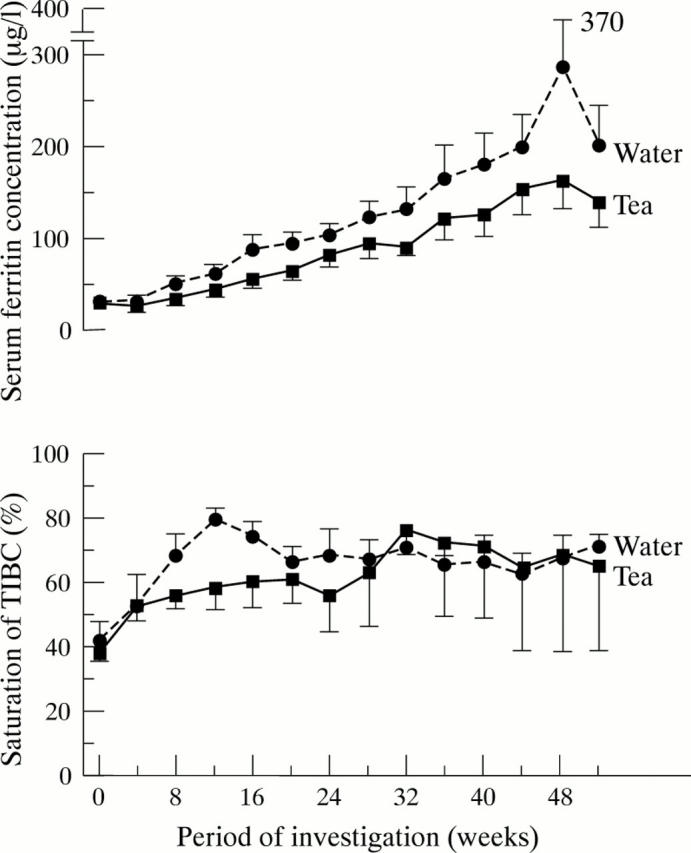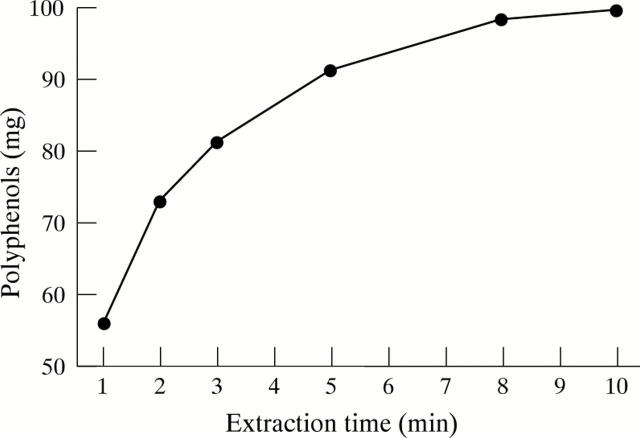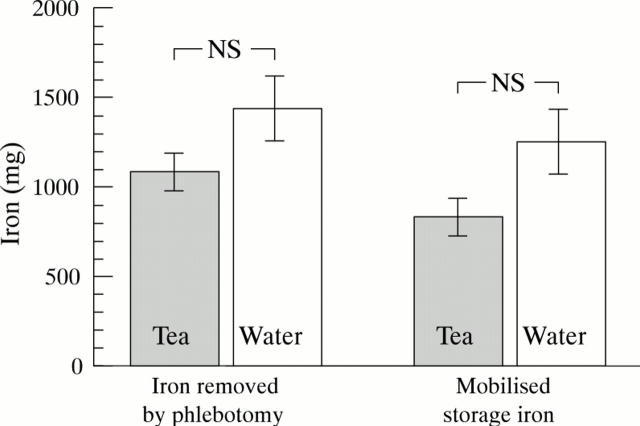Abstract
Background—Black tea is known to be a potent inhibitor of intestinal absorption of non-haem iron at least in healthy subjects. Aims—To investigate this effect in patients with genetic haemochromatosis, and, more importantly, the effect of regular tea drinking on the accumulation of storage iron in these patients over one year. Patients—Investigations were carried out on 18 patients with clinically proven genetic haemochromatosis. For the study of storage iron accumulation, they were separated into a group instructed to drink a particularly tannin rich tea regularly with meals and a control group. Methods—Intestinal iron absorption from a test meal was measured using whole body counting. Body iron stores were evaluated quantitatively by exhaustive phlebotomy, using haemoglobin, saturation of serum iron binding capacity, and serum ferritin for the assessment of body iron status. Results—A significant reduction in iron absorption was observed when the test meal was accompanied by drinks of tea instead of water. In the tea drinking group, the increase in storage iron was reduced by about one third compared with that of the control group. Conclusions—Regular tea drinking with meals reduces the frequency of phlebotomies required in the management of patients with haemochromatosis.
Keywords: genetic haemochromatosis; iron absorption; tea; storage iron accumulation
Full Text
The Full Text of this article is available as a PDF (148.4 KB).
Figure 1 .
Outline of study design. MCV, mean cell volume; MCH, mean cell haemoglobin; TIBC, total iron binding capacity.
Figure 2 .
Time dependence of extraction of polyphenols from 1.5 g "Wewesse Ceylon Broken" tea with 250 ml boiling water.
Figure 3 .

Time course of serum ferritin concentration and saturation of total iron binding capacity (TIBC) (means (SEM)) in patients with genetic haemochromatosis during one year without phlebotomy treatment.
Figure 4 .
Storage iron accumulated over one year. Columns on the left show the amount of iron removed by phlebotomy in the tea drinking and control groups at the end of the observation period; columns on the right show mobilised storage iron, calculated as iron removed by phlebotomy corrected for iron absorbed during the time course of the phlebotomies (see the text). The differences between the tea and water drinking groups are statistically not significant (t = 1.63 and 2.04; p<0.05 would require 2.12).
Selected References
These references are in PubMed. This may not be the complete list of references from this article.
- Brune M., Rossander L., Hallberg L. Iron absorption and phenolic compounds: importance of different phenolic structures. Eur J Clin Nutr. 1989 Aug;43(8):547–557. [PubMed] [Google Scholar]
- Cook J. D., Layrisse M., Martinez-Torres C., Walker R., Monsen E., Finch C. A. Food iron absorption measured by an extrinsic tag. J Clin Invest. 1972 Apr;51(4):805–815. doi: 10.1172/JCI106875. [DOI] [PMC free article] [PubMed] [Google Scholar]
- Cook J. D., Morck T. A., Lynch S. R. The inhibitory effect of soy products on nonheme iron absorption in man. Am J Clin Nutr. 1981 Dec;34(12):2622–2629. doi: 10.1093/ajcn/34.12.2622. [DOI] [PubMed] [Google Scholar]
- Disler P. B., Lynch S. R., Charlton R. W., Torrance J. D., Bothwell T. H., Walker R. B., Mayet F. The effect of tea on iron absorption. Gut. 1975 Mar;16(3):193–200. doi: 10.1136/gut.16.3.193. [DOI] [PMC free article] [PubMed] [Google Scholar]
- Disler P. B., Lynch S. R., Torrance J. D., Sayers M. H., Bothwell T. H., Charlton R. W. The mechanism of the inhibition of iron absorption by tea. S Afr J Med Sci. 1975;40(4):109–116. [PubMed] [Google Scholar]
- Feder J. N., Gnirke A., Thomas W., Tsuchihashi Z., Ruddy D. A., Basava A., Dormishian F., Domingo R., Jr, Ellis M. C., Fullan A. A novel MHC class I-like gene is mutated in patients with hereditary haemochromatosis. Nat Genet. 1996 Aug;13(4):399–408. doi: 10.1038/ng0896-399. [DOI] [PubMed] [Google Scholar]
- Gabrielli G. B., De Sandre G. Excessive tea consumption can inhibit the efficacy of oral iron treatment in iron-deficiency anemia. Haematologica. 1995 Nov-Dec;80(6):518–520. [PubMed] [Google Scholar]
- Gillooly M., Bothwell T. H., Charlton R. W., Torrance J. D., Bezwoda W. R., MacPhail A. P., Derman D. P., Novelli L., Morrall P., Mayet F. Factors affecting the absorption of iron from cereals. Br J Nutr. 1984 Jan;51(1):37–46. doi: 10.1079/bjn19840007. [DOI] [PubMed] [Google Scholar]
- HASKINS D., STEVENS A. R., Jr, FINCH S., FINCH C. A. Iron metabolism; iron stores in man as measured by phlebotomy. J Clin Invest. 1952 Jun;31(6):543–547. doi: 10.1172/JCI102639. [DOI] [PMC free article] [PubMed] [Google Scholar]
- Hallberg L., Rossander L. Effect of different drinks on the absorption of non-heme iron from composite meals. Hum Nutr Appl Nutr. 1982 Apr;36(2):116–123. [PubMed] [Google Scholar]
- Hoffbrand A. V., Wonke B. Results of long-term subcutaneous desferrioxamine therapy. Baillieres Clin Haematol. 1989 Apr;2(2):345–362. doi: 10.1016/s0950-3536(89)80021-6. [DOI] [PubMed] [Google Scholar]
- Kaltwasser J. P. Serumferritin bei Eisenüberladung. Folia Haematol Int Mag Klin Morphol Blutforsch. 1987;114(3):319–337. [PubMed] [Google Scholar]
- Kaltwasser J. P., Werner E. Diagnosis and clinical evaluation of iron overload. Baillieres Clin Haematol. 1989 Apr;2(2):363–389. doi: 10.1016/s0950-3536(89)80022-8. [DOI] [PubMed] [Google Scholar]
- Kubota K., Sakurai T., Nakazato K., Morita T., Shirakura T. [Effect of green tea on iron absorption in elderly patients with iron deficiency anemia]. Nihon Ronen Igakkai Zasshi. 1990 Sep;27(5):555–558. doi: 10.3143/geriatrics.27.555. [DOI] [PubMed] [Google Scholar]
- Merhav H., Amitai Y., Palti H., Godfrey S. Tea drinking and microcytic anemia in infants. Am J Clin Nutr. 1985 Jun;41(6):1210–1213. doi: 10.1093/ajcn/41.6.1210. [DOI] [PubMed] [Google Scholar]
- Morck T. A., Lynch S. R., Cook J. D. Inhibition of food iron absorption by coffee. Am J Clin Nutr. 1983 Mar;37(3):416–420. doi: 10.1093/ajcn/37.3.416. [DOI] [PubMed] [Google Scholar]
- Pippard M. J. Desferrioxamine-induced iron excretion in humans. Baillieres Clin Haematol. 1989 Apr;2(2):323–343. doi: 10.1016/s0950-3536(89)80020-4. [DOI] [PubMed] [Google Scholar]
- Roberts A. G., Whatley S. D., Morgan R. R., Worwood M., Elder G. H. Increased frequency of the haemochromatosis Cys282Tyr mutation in sporadic porphyria cutanea tarda. Lancet. 1997 Feb 1;349(9048):321–323. doi: 10.1016/S0140-6736(96)09436-6. [DOI] [PubMed] [Google Scholar]
- SHARPE L. M., PEACOCK W. C., COOKE R., HARRIS R. S. The effect of phytate and other food factors on iron absorption. J Nutr. 1950 Jul;41(3):433–446. doi: 10.1093/jn/41.3.433. [DOI] [PubMed] [Google Scholar]
- Salonen J. T., Nyyssönen K., Korpela H., Tuomilehto J., Seppänen R., Salonen R. High stored iron levels are associated with excess risk of myocardial infarction in eastern Finnish men. Circulation. 1992 Sep;86(3):803–811. doi: 10.1161/01.cir.86.3.803. [DOI] [PubMed] [Google Scholar]
- Schneider G. Zur Bestimmung der Gerbstoffe mit Casein. Arch Pharm (Weinheim) 1976 Jan;309(1):38–44. doi: 10.1002/ardp.19763090108. [DOI] [PubMed] [Google Scholar]
- Stevens R. G., Jones D. Y., Micozzi M. S., Taylor P. R. Body iron stores and the risk of cancer. N Engl J Med. 1988 Oct 20;319(16):1047–1052. doi: 10.1056/NEJM198810203191603. [DOI] [PubMed] [Google Scholar]
- Tuntawiroon M., Sritongkul N., Brune M., Rossander-Hultén L., Pleehachinda R., Suwanik R., Hallberg L. Dose-dependent inhibitory effect of phenolic compounds in foods on nonheme-iron absorption in men. Am J Clin Nutr. 1991 Feb;53(2):554–557. doi: 10.1093/ajcn/53.2.554. [DOI] [PubMed] [Google Scholar]
- Worwood M., Thorpe S. J., Heath A., Flowers C. H., Cook J. D. Stable lyophilized reagents for the serum ferritin assay. Clin Lab Haematol. 1991;13(3):297–305. doi: 10.1111/j.1365-2257.1991.tb00285.x. [DOI] [PubMed] [Google Scholar]
- de Alarcon P. A., Donovan M. E., Forbes G. B., Landaw S. A., Stockman J. A., 3rd Iron absorption in the thalassemia syndromes and its inhibition by tea. N Engl J Med. 1979 Jan 4;300(1):5–8. doi: 10.1056/NEJM197901043000102. [DOI] [PubMed] [Google Scholar]





